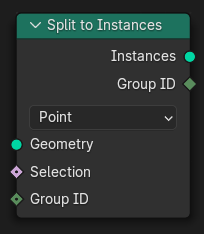拆分为实例¶

Splits a selection of geometry elements (such as faces) into groups, then turns each group into an instance.
输入¶
- 几何数据
标准的几何体输入。
- 选择
Boolean field indicating which geometry elements to include.
- 群组 ID
Integer field indicating which group each element belongs to. Elements with the same ID will be moved into the same output instance.
属性¶
- 域
The type of geometry to extract and split. This is also the domain on which the Selection and Group ID fields are evaluated.
- 点:
点、样条线控制点、顶点。
- 边:
网格边。
- 面:
网格面。
- 样条线:
曲线样条。
- 实例:
Top-level instances. Realized instances are ignored.
- 层:
蜡笔层。
Note
Geometry that doesn't match the selected domain will be removed. For example, if you choose Edge, any faces, splines, and instances in the input geometry will be lost.
输出¶
- 实例
The instances containing the grouped geometry elements.
- 群组 ID
每个实例的群组 ID。
示例¶

In the example above, we start with a grid of 1000x1000 square faces serving as "pixels." Then, we group these faces into patches by assigning them a group ID sampled from a Voronoi texture, and move each resulting instance by a random amount along the Z axis.
Note that, because the texture outputs floating point values between 0 and 1 while the group ID is an integer, all the values would be rounded to 0 or 1 and we would only get two groups. To get more variation, we multiply the texture value by 1000.